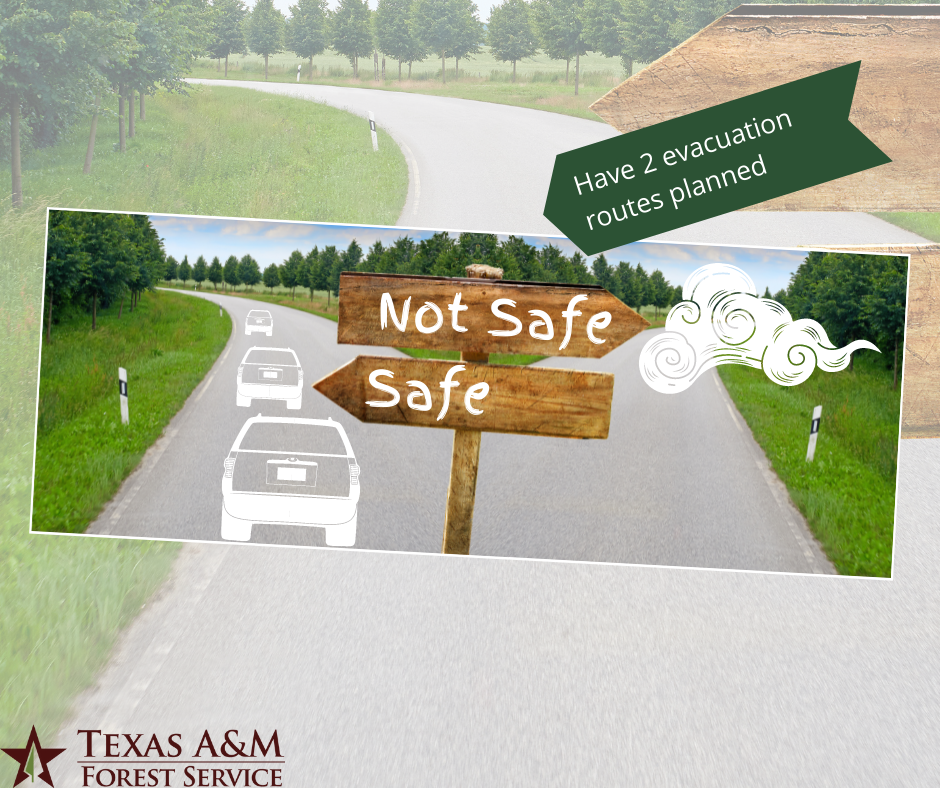Winter Holiday Season Wildfire Prevention
About 90% of wildfires in Texas are human caused, which means 90% of our wildfires could be prevented with some simple actions. During the winter holiday season, debris burning and equipment use make up 68% of all wildfires. These include: brush pile burning, burning leaves, unsafe burning of household trash, vehicle exhaust, loose trailer chains or dragging metal, farm equipment, and welding.
+ Christmas Fire Prevention
- Whether your Christmas tree is real or artificial, make sure you are taking precautions to prevent a fire and protect you and your family. Keep all trees at least three feet away from fireplaces, radiators, candles, heat vents, and lights. If your tree is real, ensure it has an adequate water supply to keep the branches and needles moist.
- If you are travelling this holiday season, please follow these tips to keep you safe:
- Check your chains... make sure they don't drag.
- Check your wheel bearings... make sure they aren't overheating.
- Check your tire inflation... flat tires can cause sparks.
- Parking or driving on dry grass can start wildfires.
- Instead of burning used wrapping paper, follow these easy tips for recycling your old wrapping paper. This holiday season, keep everyone safe and put a freeze on winter wildfires.
- Only plain wrapping paper can be recycled.
- Metallic, glitter or textured paper cannot be recycled.
- Do the "scrunch" test! Scrunch of piece of paper into a ball in your hand. Open your hand and if the paper stays in a ball, it can be recycled.
- Tape, ribbons, and bows cannot be recycled and should be removed.
- Tissue paper can be added to your compost pile.
- There are several alternatives for safe Christmas tree disposal in place of burning. Burning Christmas trees could become a hazard if the fire escapes and creates a wildfire. Here are some safe alternatives for disposal, and some that are also a great benefit to nature:
- Compost it! Branches make a great base for a compost pile.
- Chip it! Some local communities host chipping days to provide safe tree disposal.
- If possible, toss your tree into a pond to create fish habitat.
- Cut the trunk into small pieces and use as pathway edging.
- As you are removing holiday decorations from your yard and home, this is a good time to inspect your house for weak links that could welcome a wildfire this winter.
- Inspect vents... vents should include 1/8" wire mesh screening to protect against fire ember intrusion.
- Inspect roofs... roofs should be class A fire-rated, such as asphalt composition shingles.
- Inspect gutters... fallen leaves gather in gutters and make a perfect landing spot for fire embers.
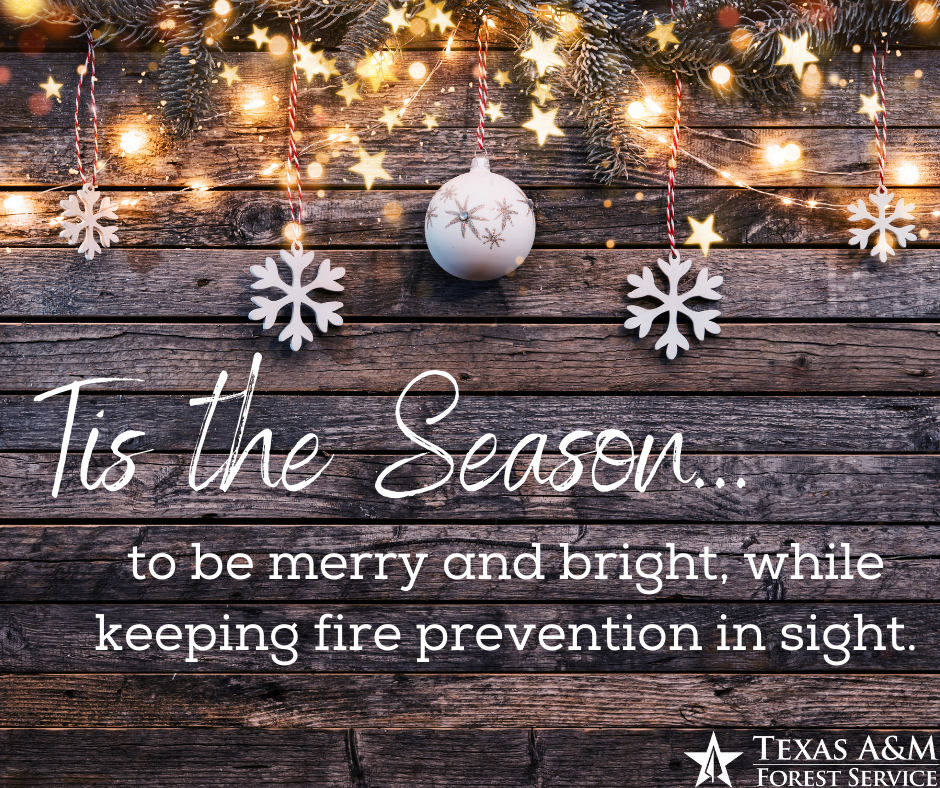
+ New Year's Fire Prevention
- Celebrate safely! Designate a responsible person to keep an eye on the cooking and the bonfire. Call 9-1-1 immediately if a grass fire of wildfire ignites.
- Before you light that New Year's bonfire...
- Check for burn bans and other burning restrictions in your area.
- Make sure your pile is located away from structures, overhead powerlines and other vegetation.
- Create a wide fire break exposing the soil around your pile.
- Keep a reliable water source close by.
- Don't forget to check the wind direction and speed.
- If you are planning to use fireworks in your New Year's celebrations, please keep these tips in mind:
- Check for local restrictions on fireworks and burn bans.
- Fireworks should be used outdoors on flat, smooth surfaces away from dry grass and flammable materials.
- Keep water, wet towels, and a garden hose nearby in case of a fire.
- Call 9-1-1 immediately if a wildfire or grassfire ignites.
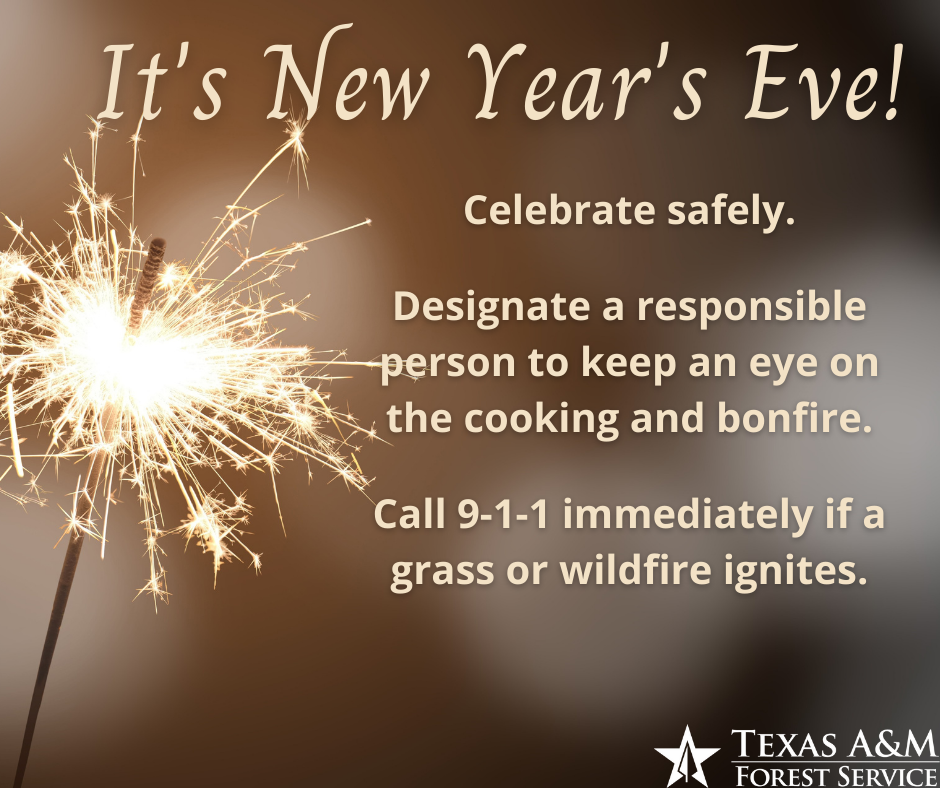
+ Sky Lantern Safety
Holiday celebrations can take on many forms. Sky Lanterns have risen in popularity in the last few years. Here are some things to consider before releasing sky lanterns to celebrate a holiday or special event:
- Sky lanterns have been banned in some municipalities. Check with your local fire marshal's office or fire department to see if sky lanterns are legal in your area.
- Sky lanterns are subject to local burn bans. Violating a burn ban in Texas is punishable by a fine of up to $500.
- Sky lanterns can burn for 5-10 minutes and travel up to 5 miles away.
- If a sky lantern starts a wildfire, you could be liable for any damages or injuries resulting from the fire.
- Always check weather conditions before conducting any type of outdoor burning, and avoid burning on hot, dry, or windy days or during periods of elevated wildfire risk.
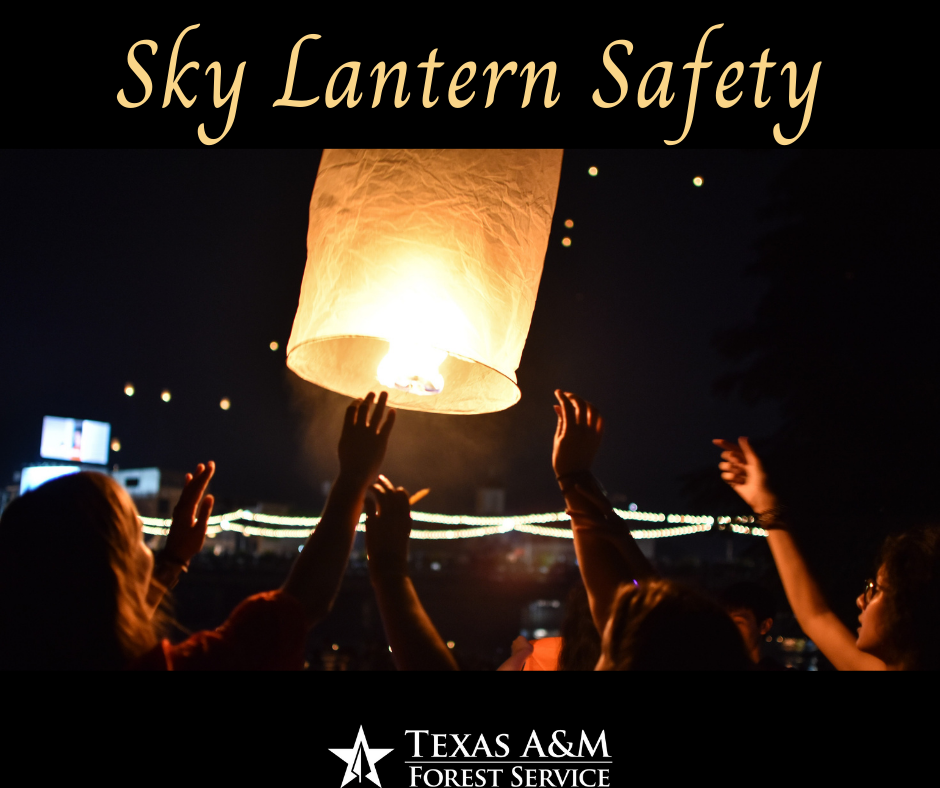
+ Debris Burning
- Check local burning restrictions before burning.
- Keep debris piles small and manageable.
- Clear vegetation and flammable material at least 10 feet away from your pile or burn barrel.
- Avoid overhead obstructions like trees, power lines and structures.
- Wet the area around the burn pile or burn barrel and have water available.
- Choose alternatives to burning when feasible.
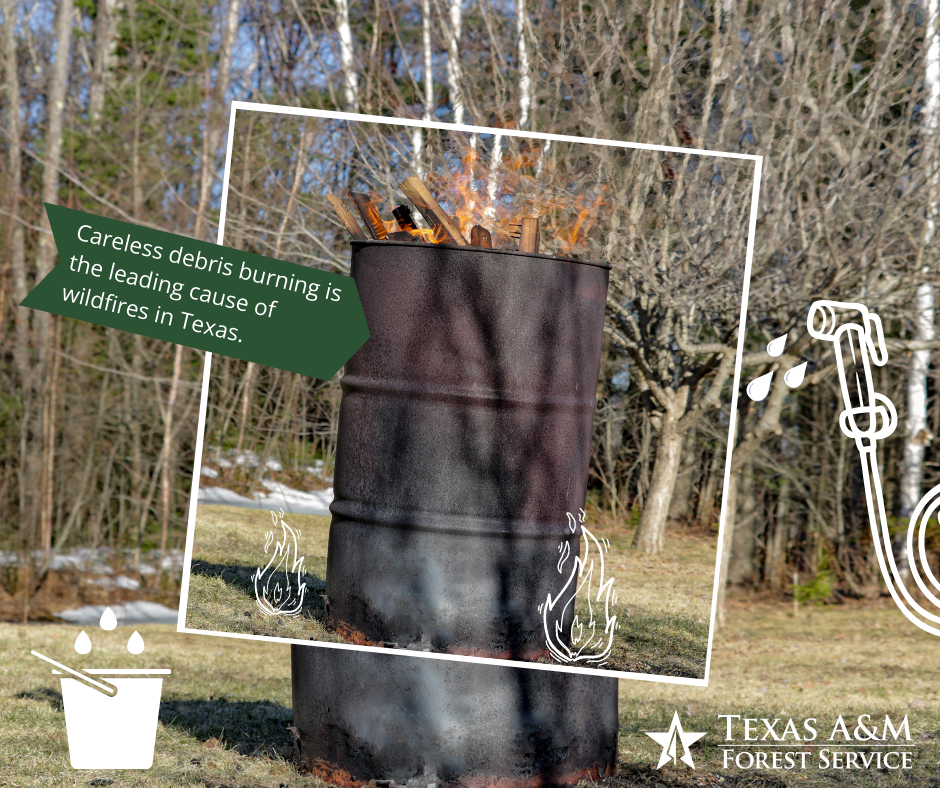
+ Equipment Use
- Avoid driving and/or parking in tall, dry grass. The underside of your vehicle may start wildfires if exposed to dry vegetation.
- Dragging chains may create sparks, causing a wildfire. Secure trailer safety chains and ensure they will not come in contact with the road.
- Underinflated tires and/or tire failure pose a wildfire hazard. Wheel rims may produce sparks if contact is made with the pavement.
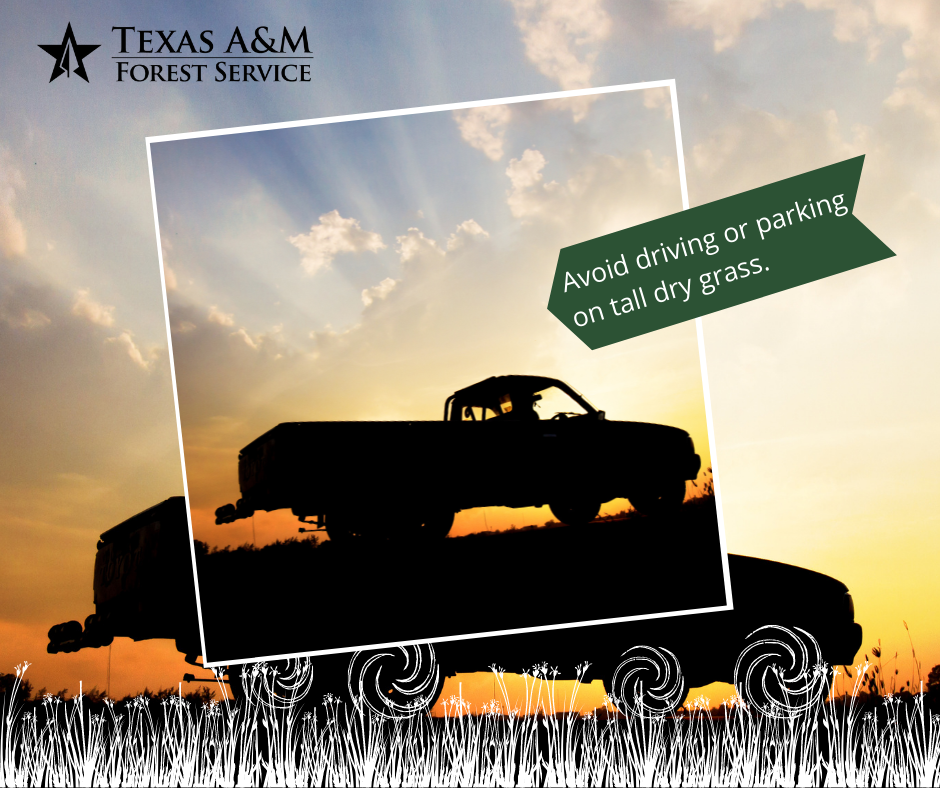
+ Arson
- Report suspicious activity to local law enforcement officials.
- Call the TAMFS Arson Hotline:
- When making a report, be prepared with a vehicle description, location, and suspect description.
- Texas A&M Forest Service offers rewards up to $10,000 for any tips that lead to a Grand Indictment.
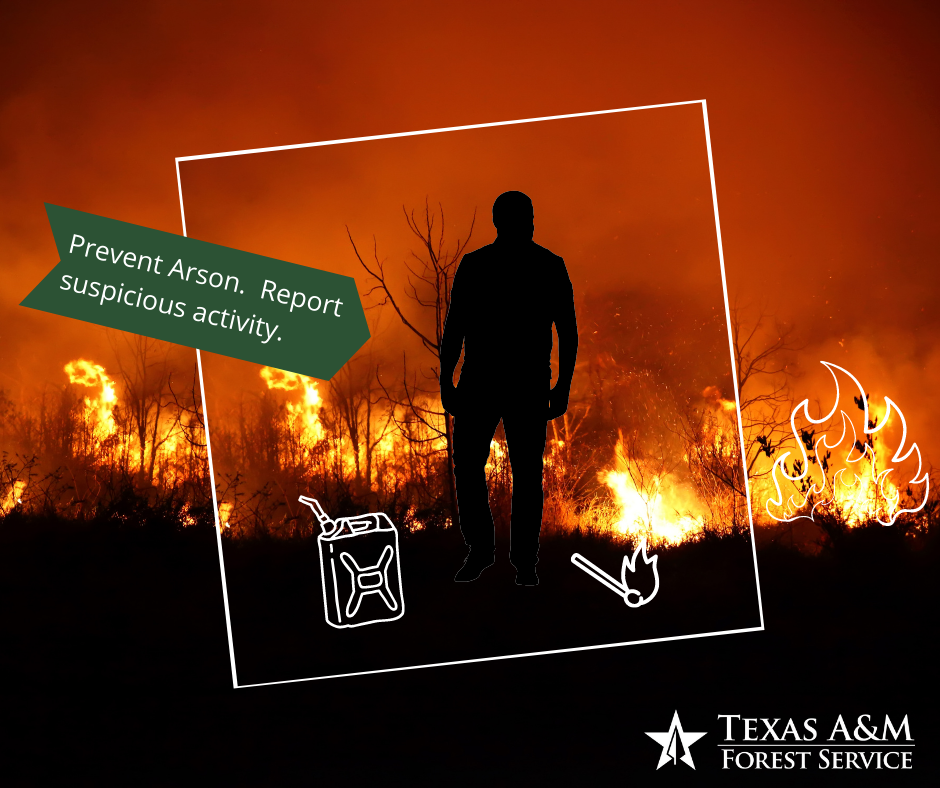
+ Campfire Safety
- Always obey local burn bans and outdoor burning restrictions.
- Do not burn when weather conditions are extremely hot, dry, or windy.
- Make a small fire in a safe and clear area.
- Never leave your fire unattended.
- When preparing to leave, soak the fire with water, stir the coals, check for heat. Repeat until out cold!
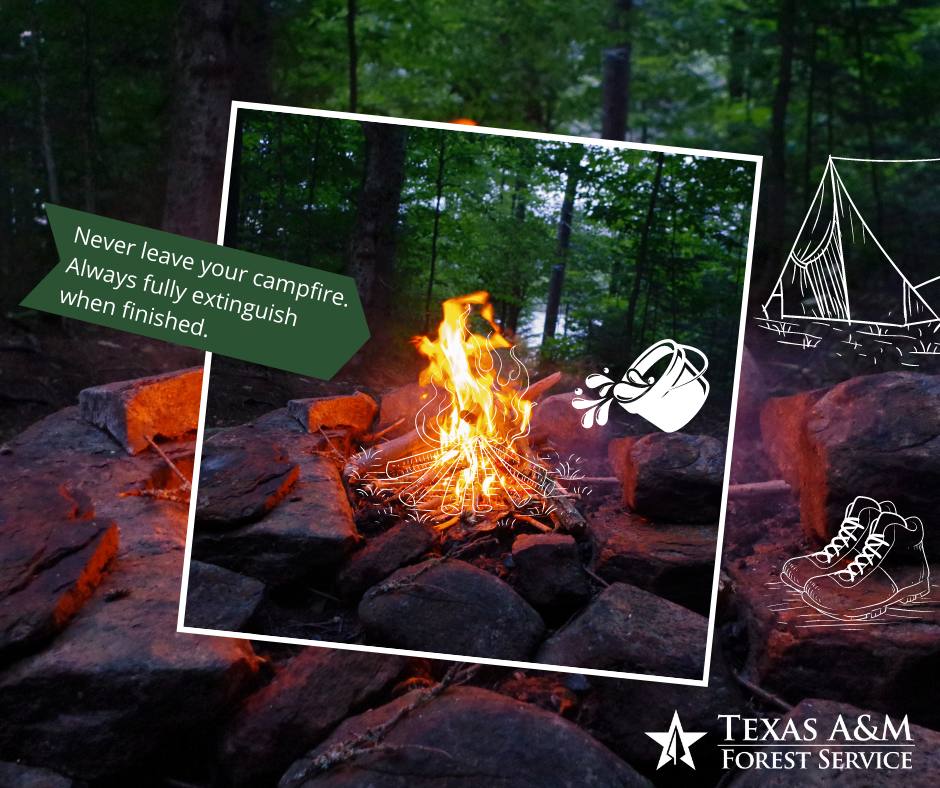
+ Personal Preparedness
Home Preparedness
- Remove accumulated debris from the roof and gutters.
- Cover all vent openings with 1/16-inch to 1/8-inch metal mesh.
- Eaves should be boxed in (soffit-eave design) and protected with ignition-resistant or non-combustible materials.
- Build or remodel your walls with ignition-resistant building materials.
- Install dual-paned windows with at least one pane of tempered glass.
Defensible Space
- Defensible space is the buffer you create between a building on your property and the grass, trees, shrubs, or any wildland area that surround it.
- This space is needed to slow or stop the spread of wildfire and it helps protect your home from catching fire.
- Proper defensible space also provides firefighters a safe area to work in, to defend your home.
- Keep your property lean and green to help protect your family and home.
- Remove dead vegetation around your home, and break up continuous vegetation with sidewalks, non-flammable landscaping, and trimming shrubs and trees.
- Store firewood at least 30 feet away from the home.
Evacuation Preparedness
- Create a Wildfire Action Plan that includes evacuation planning for your home, family, and pets.
- Assemble an Emergency Supply Kit starting with the 5 P's: people and pet supplies, prescriptions, papers, personal needs, and priceless items.
- Have enough food, water, and necessary supplies for at least 72 hours.
- Fill-out a Family Communication Plan that includes important evacuation and contact information.
- Make sure you monitor wildfires in your area and know your community's emergency response plan, evacuation orders, and evacuation centers.
Evacuations - GO!
- Go early! You don't have to wait to be told when to leave.
- Always have two evacuation routes planned so you can safely escape if one route becomes compromised.
- Review your Evacuation Plan Checklist.
- Ensure your Emergency Supply Kit/Evacuation Bag is in your vehicle.
- Cover-up to protect against heat and flying embers. Wear long pants, long sleeve shirt, heavy shoes/boots, cap, dry bandana for face cover, goggles or glasses. 100% cotton is preferable.
- Locate your pets and take them with you.
